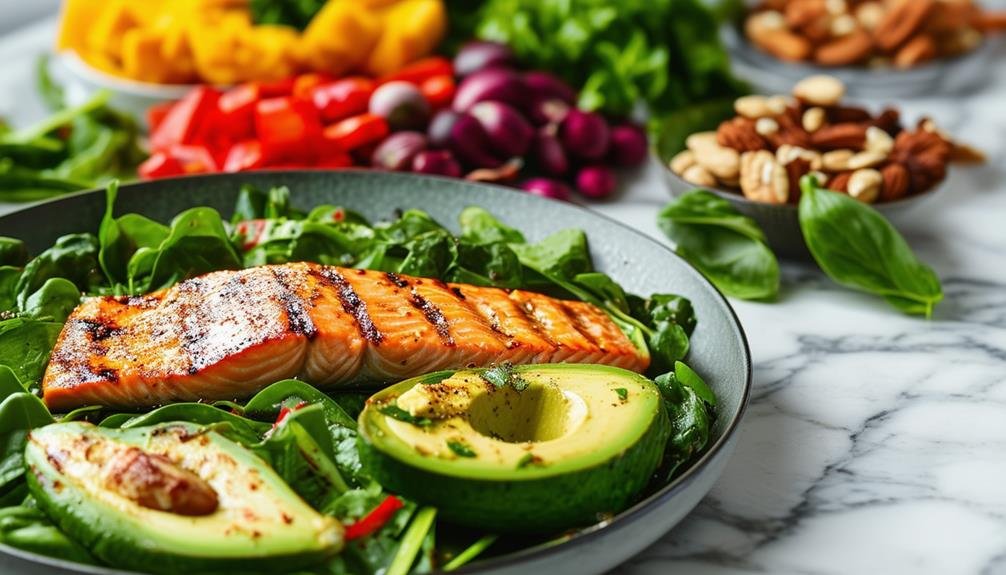To effectively tailor your keto diet for weight loss, begin by modifying your macronutrient distribution, targeting approximately 70-80% fats, 20-25% protein, and 5-10% carbohydrates.
Aim to limit your daily carbohydrate intake to between 20-50 grams, while maintaining your protein levels around 1.2 to 1.7 grams per kilogram of body weight.
Focus on incorporating healthy fats, such as avocados and olive oil, and make sure to include low-carb vegetables to ensure you receive essential nutrients.
You might also consider intermittent fasting to further boost fat metabolism.
Establishing a structured meal plan and consistently tracking your progress can help maintain accountability and facilitate necessary adjustments.
Explore various strategies to optimize your keto experience, leading to enhanced weight loss outcomes.
Key Takeaways
- Calculate your personalized macronutrient ratios with a keto macro calculator that considers your age, weight, and activity level for effective fat loss.
- Emphasize healthy fats, moderate protein, and low-carb vegetables to achieve a macronutrient distribution of 70-80% fats, 20-25% protein, and 5-10% carbohydrates.
- Implement intermittent fasting techniques, such as the 16/8 method, to enhance fat metabolism and aid in metabolic adaptation while managing carbohydrate intake.
- Incorporate regular physical activity, including strength training and high-intensity interval training (HIIT), to elevate metabolism, maintain muscle mass, and enhance weight loss outcomes.
Understanding Your Macronutrient Needs
To effectively tailor your ketogenic diet for weight loss, it's crucial to understand your specific macronutrient needs. A typical ketogenic diet consists of a macronutrient ratio of roughly 70-80% fats, 20-25% protein, and 5-10% carbohydrates. These ratios are essential for achieving and maintaining ketosis, which plays a significant role in successful weight loss.
To personalize your approach, consider utilizing a keto macro calculator. This tool can help factor in your age, weight, activity level, and personal weight loss objectives. For optimal fat loss, it's advisable to limit your daily carbohydrate intake to between 20-50 grams. Prioritize high-fiber, low-carb vegetables to maintain nutrient density while keeping carbohydrate levels in check.
Adequate protein intake is equally important. Aim for approximately 1.2 to 1.7 grams of protein per kilogram of body weight, as this helps preserve muscle mass during your weight loss journey on a ketogenic diet.
Remember, you might need to adjust your macronutrient ratios based on your individual response to the diet, activity levels, and specific fat loss goals. Understanding your macronutrient needs enables you to create a more effective and personalized dietary plan.
Tailoring Food Choices for Success
Focusing on healthy fat sources is essential for successfully customizing your keto diet to achieve your weight loss goals. Aim for 70-80% of your daily caloric intake from healthy fats such as avocados, olive oil, and fatty fish. Incorporate moderate protein (20-25%) and very low carbohydrates (5-10%) into your keto meal plan. Selecting low-carb vegetables is also vital, as they provide necessary nutrients while keeping your carbohydrate intake within limits.
Implementing an organized meal planning strategy can significantly improve your adherence to the keto diet. Here's a concise guide to help you choose the right foods:
| Keto-Friendly Foods | Benefits |
|---|---|
| Avocados | High in healthy fats |
| Olive Oil | Rich in monounsaturated fats |
| Salmon | Excellent source of omega-3 fatty acids |
| Leafy Greens | Low in carbs, high in fiber |
| Zucchini | Versatile and low-calorie |
This balanced selection of foods can address individual preferences and help prevent nutritional deficiencies. Utilize a keto macro calculator to accurately tailor your intake according to your weight and activity level. Explore various keto recipes to maintain meal diversity and motivation. Dedicating one day each week to meal planning and preparation will simplify sticking to your diet while allowing you to enjoy delicious keto-friendly meals. By implementing these strategies, you can establish a sustainable keto lifestyle that supports your weight loss success.
Incorporating Intermittent Fasting

Incorporating intermittent fasting into your ketogenic diet can significantly enhance fat burning and improve your weight loss outcomes. This method increases the duration your body remains in a fasted state, thereby promoting ketosis and boosting ketone production.
Research indicates that the combination of intermittent fasting and a ketogenic diet may lead to more noticeable weight loss and better insulin sensitivity than using each strategy separately.
A popular intermittent fasting approach is the 16/8 method, where you fast for 16 hours and consume food within an 8-hour window. This schedule can aid in hunger management and decrease overall calorie intake.
During your eating window, prioritize high-quality, nutrient-dense keto foods. Such options not only provide vital nutrients but also help maintain your calorie limits, facilitating effective weight loss.
Moreover, intermittent fasting may alleviate common side effects linked to the ketogenic diet, such as the 'keto flu.' By enhancing metabolic adaptation and decreasing inflammation, this practice supports not only your weight loss goals but also your overall health.
Meal Planning Tips and Tools
Effective meal planning is crucial for adhering to a ketogenic diet and achieving your weight loss objectives.
Begin by developing a comprehensive 7-day meal plan that includes a wide range of keto-friendly foods. This organized approach enhances daily decision-making and supports portion control, which is vital for effective weight management. Utilize a macronutrient calculator to customize your daily intake, aiming for a composition of 70-80% fats, 20-25% protein, and 5-10% carbohydrates to maintain ketosis.
Set aside one day each week for meal preparation, allowing you to create convenient, ready-to-eat options using pre-calculated keto recipes. Advance meal prep helps streamline your dietary routine and minimizes the temptation to consume non-keto foods.
Additionally, prepare a detailed grocery list based on your meal plan to ensure you have all necessary ingredients on hand, which helps avoid impulse purchases of non-keto items.
Utilizing keto recipe ebooks or online resources can offer macro breakdowns and a variety of meal ideas, facilitating the inclusion of different foods in your weight loss plan. Keeping meals varied not only boosts motivation but also ensures nutritional balance.
Staying organized with your meal planning—including grocery lists and meal prep—is essential for successfully following a ketogenic diet and achieving weight loss goals.
Enhancing Weight Loss With Exercise

To enhance your weight loss journey while following a keto diet, incorporating regular exercise is crucial.
Engaging in various workouts, such as resistance training and high-intensity interval training (HIIT), can optimize your results and help maintain muscle mass.
Exercise Types for Weight Loss
Strength training is a potent tool for increasing muscle mass and boosting metabolism, which can significantly enhance weight loss efforts, especially on a keto diet. By building muscle, you raise your resting metabolic rate, enabling your body to burn fat more efficiently.
Incorporating a variety of exercise types can further optimize your weight loss outcomes. Here are some effective strategies:
- Strength Training: Aim for at least two sessions per week to build muscle and enhance metabolic activity.
- High-Intensity Interval Training (HIIT): This technique allows you to burn a substantial number of calories in a short duration, making it perfect for busy individuals.
- Regular Aerobic Exercises: Engaging in activities such as brisk walking, running, or cycling helps improve cardiovascular health and supports fat loss.
- Adequate Protein Intake: Following a well-structured keto diet plan with sufficient protein helps with muscle recovery and maintains energy levels.
Combining Diet and Training
To effectively enhance your weight loss journey, combining a ketogenic diet with a well-structured exercise routine is vital. The synergy between a keto diet—which promotes fat utilization as fuel—and an active lifestyle significantly increases fat loss and optimizes body composition. Maintaining an active routine can lead to more efficient fat burning, especially when your body is in ketosis.
Strength training is a crucial component of this approach, as it aids in preserving lean muscle mass. This preservation is important because muscle contributes to a higher metabolic rate, even when in a caloric deficit. Additionally, incorporating high-intensity interval training (HIIT) can elevate your metabolic rate further, resulting in greater fat loss compared to traditional cardiovascular exercises. Engaging in regular physical activity also enhances blood sugar regulation, which is beneficial for individuals with insulin sensitivity.
Below is a concise guide to different types of exercises that can complement your ketogenic diet:
| Type of Exercise | Benefits | Recommended Frequency |
|---|---|---|
| Strength Training | Preserves muscle mass | 3-4 times/week |
| HIIT | Maximizes calorie burn | 2-3 times/week |
| Steady-State Cardio | Boosts endurance | 1-2 times/week |
Tracking Progress and Adjusting Plans
Tracking your progress on the keto diet is crucial for remaining on track and making necessary adjustments to reach your weight loss goals. Consistent monitoring allows you to understand how your body reacts to dietary changes and facilitates timely modifications. Here are essential points to consider:
- Regular Weight Measurements: Frequent tracking of your body weight provides insights into your overall progress toward your goals.
- Maintain a Food Diary or Use Tracking Apps: Recording your meals enables you to monitor total calorie consumption and macronutrient distribution effectively.
- Reassess Progress Every 2-4 Weeks: Since individual responses to the diet can differ, it's important to evaluate your progress regularly and make personalized adjustments as necessary.
- Modify Your Keto Plan When Necessary: If you encounter a plateau, consider reducing your calorie intake or adjusting your macronutrient ratios to reignite progress.
Frequently Asked Questions
How Do I Maximize My Weight Loss on Keto?
To maximize your weight loss on the keto diet, prioritize achieving fat adaptation, incorporate carb cycling, and monitor meal timing. Embrace intermittent fasting, select nutrient-dense keto snacks, manage portion sizes, and combine a strategic exercise routine with effective hydration practices.
What Is the 80 20 Rule for Keto Diet?
The 80/20 rule for the keto diet emphasizes the importance of balance and flexibility in your eating habits. This approach allows you to enjoy occasional cheat days, maintain portion control, and effectively balance your fat sources with protein intake. By planning meals and snacks sustainably, you can adhere to the keto lifestyle without feeling overly restricted. Remember, a healthy diet plays a crucial role, as you can't out-exercise poor nutritional choices.
What Is the Custom Keto Diet?
The Custom Keto Diet is designed to generate personalized meal plans tailored to your dietary preferences and restrictions. It includes adjustments for macronutrients, food substitutions, variations of recipes, and efficient tracking methods, simplifying meal prep and ensuring optimal nutrient timing for your dietary journey.
What Does the Perfect Keto Meal Look Like?
Imagine enjoying a delicious plate of Teriyaki Chicken accompanied by healthy fats, high-quality protein, and an array of colorful low-carb vegetables. This meal not only provides excellent flavor but also supports optimal nutrient density through mindful meal timing, appropriate portion sizes, and intelligent snacking choices.
Conclusion
Customizing your keto diet is crucial for successful weight loss. Research indicates that when participants follow a personalized ketogenic diet, they can lose up to 2.2 times more weight compared to those adhering to a standard low-calorie diet.
By identifying your specific macronutrient requirements, selecting nutritious food options, and integrating intermittent fasting into your routine, you can maximize your weight loss results.
It's also important to monitor your progress and make adjustments to your plan as needed. Adhering to these strategies can assist you in effectively reaching and sustaining your weight loss objectives.
